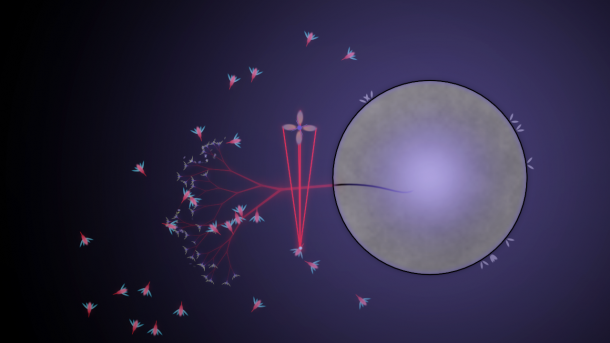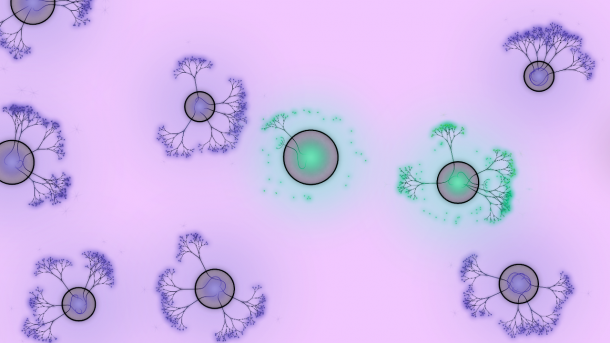Just what is Eufloria? Is it the next contender in the Playstation Network’s long-running tradition of simple and soothing art games? Is it a deep and streamlined new answer to the console RTS?
While Eufloria climbs to be the best of both worlds, it pulls up just short of the peak.
Eufloria is a real-time strategy game. Make no mistake about that. While the botanical aesthetic and maudlin, ambient audio design by Milieu may evoke feelings of quirky, genre-less games like Pixeljunk Eden or Osmos, you will still find yourself raising units, building structures and conquering enemy bases. Many staple elements of the genre have been streamlined. There is no imperative to collect resources, your units construct themselves automatically and rather than controlling your units directly you simply determine which base nodes (asteroids) that they flow to and accumulate at.
Though beautifully botanical Eufloria may be, this flowery game cannot escape its strategic roots. Eufloria is a deep and option-laden strategy game wrapped in the facade of an art game, and that non-partisanship is not necessarily a negative.

What is a negative is how unnecessary Eufloria’s design depth ends up being. Which attributes the player’s asteroid-based colonies imbue their units with (speed, damage and health) can be determined through the process of ‘terraforming’. Once these specialized units are ready for pollination on enemy worlds, they can be separated according to their specific strengths and weaknesses. In theory, certain seedlings (the games basic units) are better equipped to handle enemy seedlings and buildings than others. In practice, however, splitting your ranks according to specialization is a foolish waste of time. Instead, nearly every match I played in Eufloria resulted in me building my forces up on a single asteroid to a critical mass and then descending on my neighbors like a pollinic holocaust.
While that sense of spreading across the arena like a plague can be fairly satisfying on its own it, the experiences cannot hold up over time. Thanks to the supremely sluggish unit production speeds (the game actually features a fast-forward button; why the core experience doesn’t just run at a faster pace by default is baffling) rubber-banding AI was a non-issue and victory can easily be declared after the initial blitzkrieg. However, since total conquest is the only victory condition, the all-too-large maps demand another good 10-15 minutes of tedious extermination to complete.

All of these faults could be overlooked if the Playstation 3 version of the game’s controls weren’t so heavy-handed. The controls don’t make the transition from mouse and keyboard to the Dualshock as smoothly as the developers had probably hoped. Deciding how many units will move from one node to the next requires a rotation of the analog sticks that feels imprecise and even unresponsive. Commanding your army with precision often evokes feelings of pushing grains of sand together with chopsticks; it can be done but requires more concentration than should be necessary for such a simple task. Eufloria practically shrieks for the capacitive touch controls of an iPad or maybe the upcoming Playstation Vita. With a change of venue and less extensive maps Eufloria could be a portable smash-hit.
Eufloria is a pleasure to look at and to listen to; very much in the vein of its predominant PSN predecessors. Unfortunately, unlike the games that have come before it Eufloria never manages to stand on its own in terms of core gameplay. While it tries out some interesting ideas to slip into the console RTS space I regret to report that this experience withers before it can blossom.
This review of Eufloria is based on a copy of the game supplied to SideQuesting by Sony.



No Comments